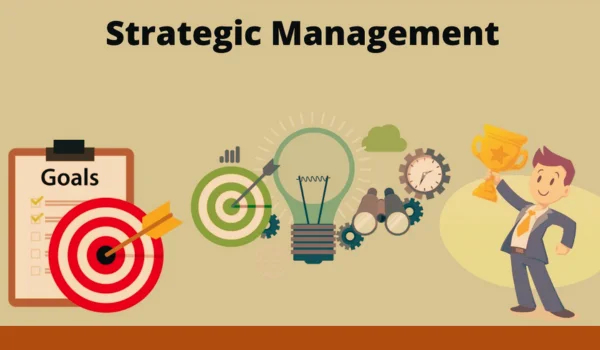Strategic management is a comprehensive process of formulating, implementing, and evaluating strategies to achieve organizational goals. It helps businesses stay competitive and adapt to dynamic market environments. While strategic management offers numerous benefits, it also has its challenges. This article explores the advantages and disadvantages of strategic management in detail.
What is Strategic Management?
Strategic management involves defining an organization’s mission, vision, and objectives and then developing strategies to achieve them. It encompasses continuous planning, monitoring, and assessment to ensure alignment with the organization’s goals and the changing market environment. Strategic management is applied in various sectors, including corporate businesses, government organizations, and non-profits.

Advantages of Strategic Management
- Clear Direction
Strategic management provides a clear sense of purpose and direction, ensuring that all employees are aligned with the organization’s goals. - Improved Organizational Performance
Organizations with well-defined strategies tend to perform better as resources are allocated efficiently, and efforts are focused on high-priority tasks. - Enhanced Decision-Making
Strategic management helps leaders make informed decisions based on thorough analysis of internal and external environments. - Adaptability to Change
The process equips organizations to anticipate and respond to changes in the market, technology, and customer preferences, ensuring long-term sustainability. - Competitive Advantage
By identifying opportunities and threats, strategic management enables businesses to leverage their strengths and mitigate weaknesses, creating a competitive edge. - Efficient Resource Allocation
It ensures that resources such as time, money, and personnel are used effectively to achieve organizational objectives. - Increased Employee Engagement
When employees understand the organization’s goals and their roles in achieving them, they are more motivated and engaged. - Risk Management
Strategic management includes risk assessment and mitigation strategies, reducing the impact of potential challenges. - Long-Term Focus
Unlike day-to-day operations, strategic management emphasizes long-term goals, ensuring sustainable growth and development.
Disadvantages of Strategic Management
- Time-Consuming
The process of strategic planning, implementation, and evaluation requires significant time and effort, which may delay immediate actions. - High Costs
Strategic management often involves hiring consultants, conducting extensive research, and using advanced tools, which can be costly for small businesses. - Complexity
The process can be complex, especially for large organizations with diverse operations and markets, requiring expertise and coordination. - Resistance to Change
Employees and even management may resist changes introduced through strategic management, leading to delays or conflicts. - Uncertainty in Results
Despite careful planning, strategies may not yield the expected results due to unpredictable external factors such as market volatility or technological disruptions. - Risk of Over-Planning
Focusing too much on planning and analysis can delay action, causing organizations to miss opportunities. - Dependence on Leadership
The success of strategic management heavily relies on the vision and skills of top leaders. Poor leadership can undermine the entire process. - Challenges in Implementation
Even well-crafted strategies can fail if not implemented effectively, often due to lack of resources, communication, or employee buy-in. - Potential for Tunnel Vision
Overemphasis on long-term goals may lead to neglect of immediate operational issues, impacting short-term performance.
Comparison Table: Advantages vs. Disadvantages
| Advantages | Disadvantages |
|---|---|
| Provides clear direction | Time-consuming process |
| Enhances organizational performance | High implementation costs |
| Improves decision-making | Complexity in large organizations |
| Enables adaptability to change | Resistance to change from employees |
| Creates competitive advantage | Uncertainty in achieving desired results |
| Ensures efficient resource allocation | Risk of over-planning delaying actions |
| Increases employee engagement | Relies heavily on leadership quality |
| Mitigates risks | Challenges in implementation |
| Focuses on long-term growth | Potential for neglecting short-term issues |
Applications of Strategic Management
Strategic management is widely used in:
- Corporate Sector: To identify market trends, optimize operations, and expand market share.
- Public Sector: For policy formulation, resource allocation, and achieving societal goals.
- Non-Profits: To align mission-driven objectives with financial sustainability.
- Small Businesses: For efficient resource use and market positioning.
Key Steps in Strategic Management
- Environmental Analysis: Assess internal strengths and weaknesses and external opportunities and threats (SWOT analysis).
- Strategy Formulation: Develop strategies that align with organizational goals and market conditions.
- Implementation: Execute the strategy through effective resource allocation and communication.
- Evaluation: Continuously monitor performance and make adjustments as necessary.
How to Overcome Challenges
- Streamline Processes: Use tools and technologies to simplify strategic planning and execution.
- Foster Communication: Ensure all stakeholders understand and support the strategy.
- Train Leaders and Employees: Provide training to enhance skills and reduce resistance to change.
- Monitor and Adjust: Regularly review strategies to adapt to changing circumstances.
Conclusion
Strategic management is a powerful tool for organizations aiming to achieve their long-term objectives. Its advantages, such as improved performance, adaptability, and competitive advantage, make it a critical component of modern business practices. However, the time, cost, and complexity involved can pose challenges, especially for smaller organizations.
To maximize the benefits of strategic management, organizations should focus on effective planning, efficient implementation, and continuous evaluation. By addressing its disadvantages, businesses can create a robust framework for growth, resilience, and success in today’s dynamic environment.

Hello, I’m Kapil Kumar, a seasoned SEO expert and blogger at WinnersList.in. My mission is to spotlight exceptional individuals and organizations across various domains. Through curated lists, profiles, and inspiring stories, I aim to celebrate outstanding achievements and inspire the next generation of champions. Join me in this journey.
